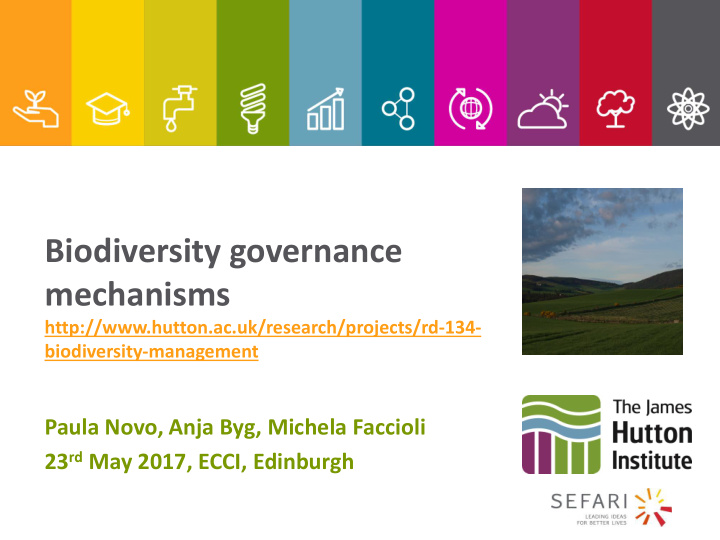



Biodiversity governance mechanisms http://www.hutton.ac.uk/research/projects/rd-134- biodiversity-management Paula Novo, Anja Byg, Michela Faccioli 23 rd May 2017, ECCI, Edinburgh
Rationale National & international agenda RD 1.3.4 (Biodiversity management). O1.1 Synthesis and assessment of current biodiversity management measures’ What are the different governance mechanisms that can be used to meet biodiversity and prosperity goals? How do they operate & are perceived by stakeholders?
Biodiversity governance: general concepts Governance is the process through which the rules and procedures that apply to members of a defined group are made, implemented, interpreted, and changed (McGinnis, 2016) Governance encompasses both processes and structures Policy instruments (Vatn, 2015) Establishment of / changes in property rights and interaction rules Legal regulations and economic incentives
Policy instruments: general categories Non-monetary regulations & moral suasion Regulations Voluntary efforts Economic instruments (not traded) Taxes, subsidies, and user fees ‘ Pigouvian- type PES’ (compensation for ES) Certification schemes & labels Economic instruments (voluntary market trade) Tradable permits ‘ Coasean- type PES’ (markets for Ess) Hybrids?
Information recorded in the database Motivations for the design/implementation Definitions – how is biodiversity understood? Advantages and disadvantages Performance / evaluations ( in general, lack of information for this ) Other public goods produced Role of stakeholders Funding, payments Related policies
Policy instruments map ( never ending… ) International & National Voluntary efforts Regulations Advisory services designations (SSSIs, Natura, Demonstration farms National Nature Reserves, etc.) Awards & competitions Controlled Activities Regulations Campaigning Wildlife Trade Regulations Volunteering Degree of commodification Environmental Impact Assessment Economic – not traded Labelling & branding SRDP Networks ‘Greening’ CAP Collective actions & partnerships Stewardship schemes Best practices Sustainable Land Management schemes Pilots (peatland code, ESs) Management agreements Biodiversity certification Tax & fees Economic – traded Conservation trust PES & MES ‘not in silos’ – hybrid Eco-accounts instruments Offsets Biodiversity banking Mitigation banking Biodiversity derivatives
Key results Approx. 100 examples, in Scotland most of them under ‘regulations’ and ‘voluntary efforts’ ‘Co - constructed’ with stakeholders – what knowledges to include? Hybrid nature of most policy instruments – co-existence of internal & external motivations? Opt-out vs. opt-in? Policy instrument Advantages Disadvantages Challenges Regulations Protected by law Controversial Must retain status Integrate priorities Subject to external pressures Poor understanding of performance & networks Voluntary efforts Intrinsic motivation Biodiversity not Low participation Low cost (for public) (necessarily) an explicit Hard to manage Social capital aim Collective action problems Economic Financial incentives Difficult to link actions to Investment risks & instruments (not Increased efficiency outputs uncertainties traded & traded) Higher transaction costs Develop & monitor Cultural & ethical indicators concerns Contract allocation
Next steps Interviews focusing on current experiences with different instruments how could existing mechanisms be improved what other mechanisms could be used Report due in Sept’ 17
Thanks to the RESAS Strategic Research Programme 2016-21 paula.novo@hutton.ac.uk
Recommend
More recommend